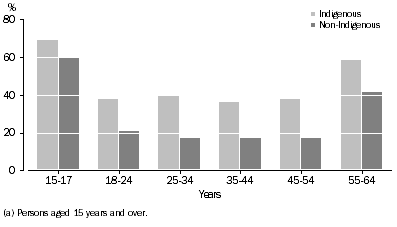PARTICIPATION IN THE LABOUR FORCE
People who participate in the labour force are either employed or unemployed. In the 2006 Census, 55% of Indigenous people aged 15 years and over were participating in the labour force. The participation rate was higher for men (61%) than women (49%).
Overall, the participation rate was ten percentage points higher for non-Indigenous people, at 65% in the 2006 Census. When the population is restricted to people aged 15-64 years in order to adjust for the larger proportion of older people in the non-Indigenous population (with low participation rates), the difference in labour force participation rates changes to almost 20 percentage points. The participation rate of Indigenous people aged 15-64 years was 57%, compared with 76% for non-Indigenous people.
In the 15-17 year age group, the Indigenous participation rate was 9 percentage points lower than the non-Indigenous participation rate. In each of the other age groups (18-24, 25-34, 35-44, 45-54 and 55-64 years) the Indigenous participation rate was about 20 percentage points below the non-Indigenous participation rate.
For the Indigenous population, the labour force participation rate was lower in more remote geographic areas (59% in Major Cities compared with 50% in Very Remote areas).
labour force participation rate(a), by remoteness areas

Persons not in the labour force
More than two in five (43%) Indigenous people aged 15-64 years were not in the labour force according to the 2006 Census (the labour force participation rate for this age group was 57%). Some people are not actively engaged in the labour market for reasons including caring responsibilities, study, illness, disability, retirement and/or lack of labour market opportunities in their area. The number of people who are not participating in the labour force provides an additional indicator, beyond the number of unemployed people, of the potential additional workforce in the population.
The proportion of Indigenous people aged 15-64 years who were not in the labour force in the 2006 Census was higher than that of non-Indigenous people (43% and 24% respectively). In every age group, except the 15-17 year age group, the proportion of Indigenous people who were not in the labour force was between 17 and 22 percentage points higher than the proportion of non-Indigenous people. The proportion of Indigenous people not in the labour force for the 15-17 year age group was 9 percentage points higher than that of non-Indigenous people.
persons not in the labour force, by Age Group(a)

 Print Page
Print Page
 Print All
Print All